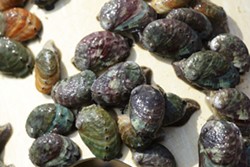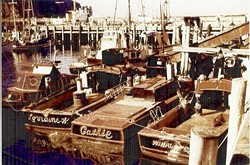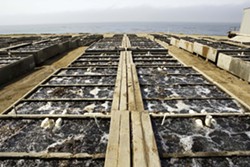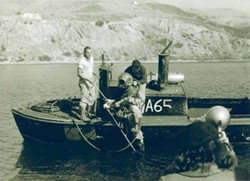The snails did go quickly
Epicures and divers await an abalone resurgence from the abyss
By Alastair Bland[{
"name": "Ad - Medium Rectangle CC01 - 300x250",
"id": "AdMediumRectangleCC01300x250",
"class": "inlineCenter",
"insertPoint": "8",
"component": "2963441",
"requiredCountToDisplay": "12"
},{
"name": "Ad - Medium Rectangle LC01 - 300x250",
"id": "AdMediumRectangleCC01300x250",
"class": "inlineCenter",
"insertPoint": "18",
"component": "2963441",
"requiredCountToDisplay": "22"
},{
"name": "Ad - Medium Rectangle LC09 - 300x250",
"id": "AdMediumRectangleLC09300x250",
"class": "inlineCenter",
"insertPoint": "28",
"component": "3252660",
"requiredCountToDisplay": "32"
}]
For California’s abalone divers, it was the best of times, at the expense of a seemingly endless resource. A community of pals and partners, the divers had as much catch as they could grab. The daily commercial limit in the 1970s was 20 dozen black abalone per permit, per landing—a bit less for the reds, pinks, greens, and whites—and the ocean bed was covered with the big sea snails, which provided some 300 commercial divers in Southern and Central California lucrative livelihoods. The California abalone population has suffered a dramatic fishery collapse and likely will never return to its former abundance. Some snails still crawl on the seafloor at San Miguel Island but the divers are long gone.
“We’d set up an assembly line of people,” Westlotorn, 58, reminisced, “and one would shuck them, another would slice them, the next person pound them, and finally we’d fry them. We ate so much abalone. We could eat all we wanted. People loved it, both as a food and as a social occasion, and no one thought it would ever end.”
Sixty-year-old Steve Rebuck, a painting contractor in San Luis Obispo, was born on Santa Catalina Island, straight into the ab fishery as the son of a diver. The resource, Rebuck remembers, was magnificent. His father owned a fleet of five boats in the 1950s, and each vessel caught, processed and sold 200 dozen abalone each per week —a total of 12,000 abalone weekly for the small fishing company.
Divers could make $150 to $200 per day—not an insignificant sum today but a fortune 30 years ago. After several years of deckhand work while in high school, Jim Marshall plunged into this lucrative trade at the age of 19. In one particularly profitable month early in his career during the early 1970s, the young diver earned more than $1,800. Now 56 years old, Marshall dives for urchin.
But it was the liberal lifestyle that made abalone diving a worthy pursuit, and for divers in the 1950s and ’60s, the future was wide open. Laws and regulations governing harvests were few and a life on the ocean was a life of one’s own, with divers essentially determining their own seemingly boundless salary. The per-landing limit allowed making two or more landings per day, time permitting, and the Department of Fish and Game enforced no annual limit.
Best of all, there was no hurry. Marshall and his deckhand sometimes stayed at the Channel Islands overnight while stockpiling hundreds of abalone on the deck, in the shade and under wet burlap, or kept fresh in live-wells. Marshall and others dived with hookah gear, and a diesel-powered engine pumped air through a hose down to the divers, who pried the abalone off the rocks with two-foot bars. Rebuck was diving several years before and used “heavy gear,” which included a sealed helmet, a canvas “dress,” a weight belt and weighted shoes. An onboard hose sent air southward, and on the bottom Rebuck walked like a spaceman, filling sacks with abalone.
Back at the dock in Santa Barbara, the snails were unloaded and divers would make another run to the islands the next day or maybe the next week; many, like Marshall, had no boss, the world was their oyster, and a pearl of a world it was.
But as surely as hungry buyers met the boats in the harbor, the abalone beds began to thin out. Looking past a potential problem was easy at first, admits Marshall, who explained, “We’d just say, ‘Well, I guess they all moved to another spot’.”
So the divers would migrate to fresh abalone beds. In those days, most of Southern California was game for commercial harvest, so finding more abs elsewhere was easy. Yet the fishermen couldn’t ignore the ominous feeling that this resource—along with their healthy livelihood and freewheeling lifestyle—was beginning to fade.
“I think people anywhere can always visualize in their minds that things won’t always be the same,” Marshall reflected. “Thing is, people also tend to ignore things that are staring them in the face.”
Rebuck says that by the early 1960s, the abalone off Morro Bay began to dwindle. His father, who worked the area when not at the Channel islands, could only pull in 200 dozen or so per week at the local kelp beds, and Rebuck began to reconsider his own future career as he saw that abalone abundance was not boundless.
There was no ignoring the matter by the 1980s, when the fishery plunged in a catastrophic collapse. The state Department of Fish and Game (DFG) acted quickly in the 1990s, banning black abalone harvest in 1993. In 1996, white, green, and pink abalone were put under protection, and the following year legislation ended the harvest of red abalone south of Marin County. With that, a way of life came to an end and, in the remaining abalone beds, the quiet returned.
But among circles of former ab divers—many of whom now collect sea urchins for a living—talk is growing louder about the possibility of reinstating an abalone fishery at San Miguel Island, the wind-blown and westernmost Channel Island, located just south of Point Conception and about a five-hour boat ride from Santa Barbara. The idea, in fact, is even being seriously considered by the DFG, but, as with all discussions of harvesting an imperiled species, opposition is strong. All parties do agree, however, that a new future in the abalone industry means understanding its failed past.
The vanishing snail
Debate still continues about why the abalone vanished. Some blame the DFG’s lack of management. In some regions, particularly the Central Coast, sea otters contributed to the decline. Recreational divers also took a small but steady toll. But below Point Conception in Southern California, the blame is mostly shared by poachers, legal divers, and withering foot syndrome.
Caused by mysterious bacteria that are apparently harmless in cold water, withering foot takes effect during warm water regimes, like El NiÒo, when it interrupts the digestive processes of abalone and leads to malnourishment. That causes the infected snail’s foot to weaken and wither, and eventually the animal slips from the rock and cartwheels to the seafloor. Unable to reattach, the abalone become fast prey for an ocean’s worth of predators—or they starve.
“When the abs started falling off the rocks at 10 percent attrition per year, we thought, ‘Oh my God, what’s going on?’” remembered Marshall. On the bottom, he and other divers began encountering upside down abalone—mostly blacks and greens—with increasing frequency, and empty shells accumulated in the kelp beds.
Westlotorn, who started as a recreational picker and became a professional diver by age 20, believes the disappearance of abalone was not due so much to withering foot, but to poaching. “Poaching killed the industry,” he explained. “It wasn’t withering foot, it wasn’t recreational diving. The divers didn’t want to believe it. They were in denial because the poachers were also their customers in some cases. If everyone believed that poaching was a problem, they would have closed the market.” He remembers often seeing shell piles on the ocean floor, indicators of at-sea processing of poached abalone that the DFG asked legal divers to report. “But they kept their mouths shut because they knew the DFG would close the season,” Westlotorn explained.
Rebuck says divers have been scapegoated; otters, he says, wiped out the abalone. During the 1960s and subsequent decades, the mammals rebounded from their own near-disappearance and repopulated the Central Coast. In perfect negative correlation, abalone vanished —but otters cannot be blamed for the abalone’s collapse from Santa Barbara south. There, sport divers did it, said Rebuck. Recreational divers in Southern California harvested four million pounds annually for at least a decade, he says, citing “an obscure report” from the DFG in 1971 that claims recreational divers killed an additional four million pounds each year by accidentally cutting them—abs are hemophiliacs and easily bleed to death—with screwdrivers, knives, and other crude tools of the trade before measuring them, finding them undersized, and unknowingly leaving them to die. In the 1970s, the commercial fleet’s long-sustained annual harvest of two million pounds— such numbers had been recorded from 1916 through 1960—suffered a precipitous collapse, and it was due to sport divers, Rebuck asserts.
Whatever the true cause, the abalones once teemed but have disappeared. The last days of low-tide rock picking came in the late ’70s and then the islands began to dry out. Near-shore locales went first, from the tide pools down, and San Miguel eventually remained as the last stronghold of red abalone south of the Golden Gate Bridge. By 1985, the entire fishery was only bringing in between 200,000 and 300,000 pounds each year. Of that, about 120,000 pounds came from San Miguel.
Managing the abs
Change comes very slowly for these sluggish mollusks, and among research, recreational, and commercial divers, there is no consensus about whether red abalone numbers have grown, declined, or stayed steady at San Miguel Island since the last legal ab was plucked 11 years ago. Yet the very legislation that shut down the fishery mandated that the DFG develop a recovery plan and consider one day resuming the harvest. In December 2005, the Abalone Recovery and Management Plan (ARMP) went into effect and, today, motions are underway to potentially revive San Miguel’s fishery.
In 2006, the DFG appointed 12 people from recreational, commercial, and scientific backgrounds to the Abalone Advisory Group (AAG). With other experts, the group is considering such harvesting standards as total allowable catch, proper allocation to sport and commercial divers, and methods of monitoring the population. Discussions assume that the fishery will someday reopen—but that may never happen. The commercial divers on the AAG say that they’ll foster innovative means of management, self-regulate their catch, and carefully watch the resource.
“We have the incentive to learn and do this right and preserve the fishery,” said Marshall, who is among the several dozen divers advocating a resumption of the fishery. “We’re trying to build a future here.”
Rebuck has been instrumental in writing and advocating portions of the ARMP. He points out that the plan would allow a total take of 17,000 abalone annually among anywhere from 36 to 90 divers. Ten dollars per abalone would go up front each year to the DFG for research and law enforcement, he says.
“When we first brought this to the table, the Fish and Game Commission was really excited about it. There was a tremendous amount of enthusiasm for what we wrote, but now I’m just disgusted by the state’s progress. They’ve lost all interest, apparently.”
State biologists, Rebuck believes, have been swayed by environmentalist politics—not data—and are bent on deflecting any sincere efforts to reopen the fishery. There is some personal resentment, too, he says.
“I had one biologist tell me a few years ago, ‘You divers make too much money.’ You have these scientists who spent years in college getting a master’s degree, and then you’ve got a fisherman who maybe graduated from high school making $150,000 in abs and urchins, and (the scientists) don’t like that.”
Milo Vukovich, president of the Sonoma County Abalone Network, a coalition of conservation-minded recreational divers, doesn’t believe the commercial divers will responsibly manage the fishery if given the chance.
“We all saw that commercial divers didn’t protect the resource when they had it, so why would they do it now?” he asked. “Nothing’s even changed out there in 10 years because abalone grow so slowly.”
A benchmark guiding the resumed-fishery discussion considers the abalone population on California’s North Coast. The remote region hosts an unmatched abundance of large red abalones, which blanket the near-shore bottom from Sonoma County to Oregon. Recreational diving for the animals is still legal there, and by most accounts the population is well managed and healthy, despite out-of-control poaching.
The DFG has conducted numerous surveys in recent years and found red abalone in excess of 7,000 and 8,000 per hectare, or 10,000 square meters. Density is critical because abalones are “broadcast spawners,” meaning that individuals release clouds of sperm and eggs to drift freely in the water column. If a male and female are not within a yard of one another, their spawn will likely dissipate without a single gamete fertilized. The hectare counts have been plugged into the ARMP to produce two figures of significance: the “minimum viable population” density of 2,000 abalones per hectare and the “minimum sustainable fishery” density of 6,600 per hectare. These numbers have been tentatively set as goals for the San Miguel Island population.
But survey dives in the summers of 2006 and 2007 found an average density of just 1,200 red abalones per hectare at the island. By these numbers, the discussion about a rebirth of the fishery should immediately halt because, according to the ARMP’s estimated “minimum viable population,” San Miguel Island’s red abalone is barely clinging to existence.
Rebuck argues otherwise. He refers to an isolated site at San Miguel Island that in 2001 bore a whopping 10,000 abalone per hectare. According to the National Park Service, however, that density has since dropped to 5,000.
DFG senior biologist Ian Taniguchi suspects that such numbers came from isolated locales of tremendous abundance not reflective of the ecosystem. “For a number like that, you probably have one data point with a density that would have been equivalent to 10,000 per hectare.”
Rebuck argues that the minimum density figures assigned by the DFG are “made up” and “arbitrary.” Research, he says, has shown that ab divers, both recreational and commercial, can work in zones bearing just 75 red abalones per hectare. Rebuck also explains that large abalone are non-productive members of the population, breeding only occasionally and non-prolifically. Thus, he says, divers actually serve the species by removing the 8-inch-and-larger abalone, making room for young, robust breeders.
Taniguchi disagrees. First, while large abalone may spawn less frequently with increased age, the net potency of large red abalone far exceeds that of the younger demographic. He defends the minimum viable population figure, which comes from a blend of data from studies in South Australia and at Santa Rosa Island. There, explains Taniguchi, the red abalone dwindled to almost nothing from a measured pre-study density of 1,000 per hectare. No otters were present during the collapse—only humans. Another research dive scheduled for early fall at San Miguel will add to the data.
Abalones’ allure
It may seem strange that tough, rubbery, mollusk flesh drew so many vessels and still mobilizes about 40,000 sport divers every year on the North Coast. But abalone is delicious if properly tenderized. Pounding thin slices of the meat is the most common softening technique, though other means are effective. Some divers recommend carefully avoiding injuring the animals when prying them from the rocks. Gently handled before finally going into the freezer, such specimens die peaceful deaths. Their muscles relax, and when defrosted the snails can be floppy soft. Pressure-cooking a whole abalone foot for an hour also results in a tender hunk of meat and precludes any need to pound it.
The most popular abalone recipe consists of coating sliced and pounded abalone in bread crumbs, then quickly frying the pieces in oil. Some chefs wrap the foot in a towel, pound it until pulpy, enclose the two-pound glob in foil and grill it. Others make sashimi and ceviche.
Aquaculture currently feeds the appetite for abalone in Southern California. The DFG established one of the first farms for research purposes in the 1970s at their Granite Canyon Marine Lab near Carmel, but various operations have come and gone through the years; today, a half-dozen large farms in California—most of them south of Half Moon Bay—sell hundreds of thousands of pounds of abalone per year at a combined price of almost $10 million. Most of the catch goes to expensive restaurants and foreign markets. The farms are all either on the water or adjacent to it and are considered highly sustainable facilities. They pump thousands of gallons of seawater per minute through a procession of open-topped cement tanks, where the snails cling to the walls and munch fresh fronds of fast growing giant kelp, clipped from nearby beds.
The Abalone Farm in Cayucos is the state’s largest farm, selling one million red abs, or about 100 tons, per year to distributors, retailers and restaurants, with about 30 percent going to Japan. The “crop” is harvested at four to five years of age, when the snails have reached a live weight of approximately four ounces each and just under four inches across the shell. A single abalone of this size bears about one-and-a-half ounces of meat, and retailers in the area carry them at $5 to $20 each. By comparison, the foot alone of an average eight-inch, 15-year-old red abalone weighs approximately two pounds, and the largest recorded red ab foot weighed more than six pounds.
Will they ever return?
There is no certainty that the Fish and Game Commission, the DFG’s governing body, will reopen a legal season on San Miguel reds, yet the AAG continues to prepare alternative harvest plans. Jessie Altstatt, 41, science director for Santa Barbara Channelkeeper and a member of the AAG, has spearheaded a very unusual plan by which commercial and recreational divers would be employed, through state and private funding, to carefully pry abalone from the rocks and then transfer the snails alive to unpopulated nearby regions in an attempt to reestablish vanished stocks. Attentive monitoring would determine whether the fished population could withstand a limited harvest and whether the transplanted populations would take root.
“I think testing the total allowable catch model before opening up the consumptive fishery is the most prudent and cautious approach there could be,” said Altstatt, who has participated in research dives at San Miguel and been slightly perturbed by the lack of small abalone—although she says many were likely out of sight in cracks and crevices, which is standard protocol for the one- to three-inchers. “But if there had been good recruitment anytime after the fishery closed,” she continued, “you’d think there would be more abalone moving up through a smaller size class. About the smallest abalone I measured was six inches.” Most, she explained, were larger than seven inches across the shell. “In a population where you’re going to be harvesting,” said Alstatt, “I think you want there to be more smaller ones than big ones so that you’ll still have a resource the next day.”
Urchin diver and president of the California Abalone Association, Chris Voss, 47, would like to see a system of self-management govern the fishery. Divers would bear responsibility for safeguarding the abalone population from abuse. Voss assures that the future industry would be different than the past and says that much of the recreational diving community has expressed unjust opposition to reopening the fishery.
“This has gotten characterized and misrepresented as a group of commercial fishermen trying to attack the last remaining island of abalone,” he said.
Certainly, San Miguel Island’s colony of abalone truly is an isolated remnant of a once-tremendous resource. Even Northern California’s relatively plentiful red abalone population is merely a small remnant; an estimated 86 percent of the state’s historical red abalone lived south of the Golden Gate Bridge. Humans are not solely to blame for the collapse.
Sea otters are documented devourers of abalone. Since being nearly exterminated 200 years ago by fur hunters, the predators’ numbers have steadily climbed. In regions where otters thrive today—primarily the Big Sur Coast—abalone live quiet, cryptic lives deep in crevices. Any that venture into open water are likely to become a quick meal. A report from the Central Coast in 1994 showed that within six years of sea otters’ reappearance near San Simeon, red abalone numbers crashed by 84 percent before stabilizing at seven percent of the estimated 1965 population. The DFG’s Taniguchi says that the red abalone abundance on the North Coast, void of sea otters, is an artificial situation.
Locally, red abalone may be recovering. Biologist Terry Lilley, with Save Our Seas, regularly dives at MontaÒa de Oro State Park, and he reports healthy numbers—20 to 40 per dive—of large and small red abalone clinging to various reef locations. Otters take an evident toll and black abalone have not rebounded, likely due to an overabundance of sea urchins, says Lilley, which compete for food.
For Rebuck, Marshall, Westlotorn, and others who have revered and eaten the big snails for much of their lives, the halcyon days of grabbing, shucking, pounding, and frying ended 11 years ago. If a deep low tide ever exposes thick beds of legal-sized abs, it won’t be here in our lifetimes. But a new era could be waiting, just over the horizon, about 60 miles to the southwest and 20 feet below.
Contributing writer Alastair Bland can be reached by contacting the editor at [email protected].
Latest in News
Readers also liked…
-

Coast Unified teachers upset over new position's salary and qualifications
Oct 20, 2022 -

SLO police identify alleged driver who hit and killed couple
Dec 22, 2022 -

When the levee breaks: Oceano residents, county officials walk a tightrope of regulations to manage Arroyo Grande Creek, which some say led to the levee's failure in January
May 18, 2023










